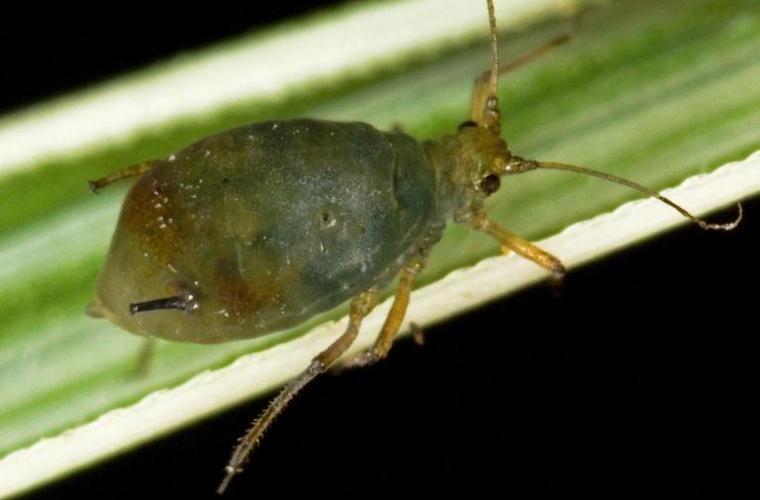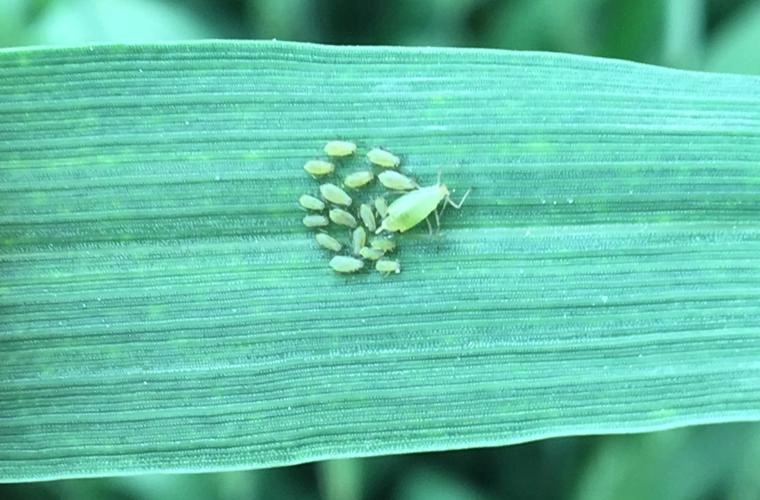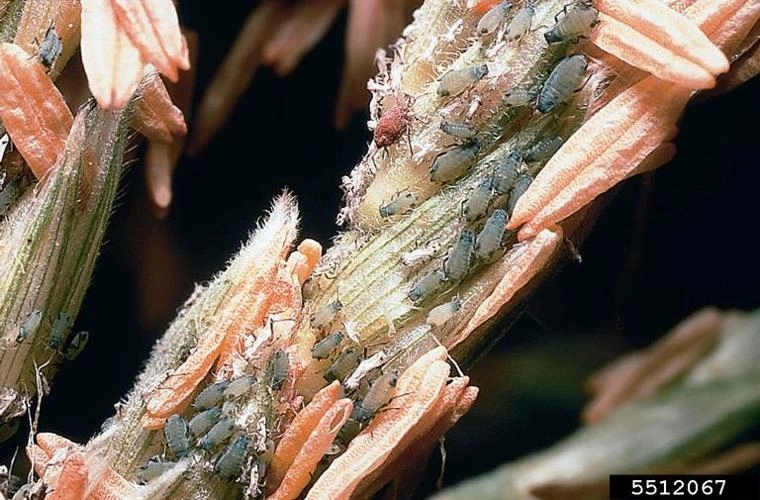Identification
Cereal aphids are a complex of three different species that infest cereals.
Bird cherry-oat aphids (figure 1) are the most common aphid found in Ontario cereals. These aphids are small, 2 mm (1/12 in.) or less. Adults are olive-green with patches of red-purple near the rear of the abdomen, between a pair of “tailpipes” called cornicles. The cornicles and legs are pale green while their antennae are long and black. Younger aphids are light green. This species is bulb shaped.

English grain aphids (figure 2) are the largest of the three species found on cereals and is bright green, (sometimes red) with long legs that may appear green to black. They have long legs and long black antennae and cornicles.

Corn leaf aphids (figure 3) are bluish-green, with black legs, cornicles and antennae. They are somewhat rectangular shaped. They are more often found on corn but can sometimes infest wheat.

Biology
Cereal aphids have overwintered in Ontario, particularly in mild winters with prolonged snow cover. Fields planted in late summer or early fall (August/September) are at highest risk of fall infestations.
Like all aphids, these species are soft-bodied, winged or wingless, with piercing and sucking mouthparts that suck the juices (nutrients) from young plant tissues. Aphids secrete a sticky substance referred to as “honeydew,” which can cause sooty mould.
Seldom a direct problem in Ontario. On young plants, aphids cluster on the upper sides of leaves near the base of the plant. Eventually, aphids will climb to the top and can be found on leaves and leaf collars. High populations can result in fields appearing to have large bronze patches. Cereal aphids are vectors of barley yellow dwarf virus (BYDV).
Scouting Notes
Fall scouting for cereal aphids is important, as early-season infection with BYDV is most harmful to cereals. In spring, scout the field weekly prior to heading.
Examine 20 stems in five areas across the field. Shake the plants over a piece of paper and count the number of aphids present or look for colonies specifically at the leaf collars. In the fall, the aphids usually hang out at the base of the plant, either within the whorl or even underground at the base if night temperatures are quite cool.
Also make note of any predators present and whether the aphids are parasitized (mummies) or infected with a fungus.
Thresholds
Cereal aphids reaching threshold is a rare event in Ontario.
On-farm trials done in Ontario have not found an economic benefit to spraying aphids, though if populations reach an average of 12-15 aphids per stem prior to heading, an insecticide application may be required.
Once wheat is heading, 50 or more aphids per head are needed before insecticide is warranted.
Management Notes
Preventative or Cultural Options
- Avoid planting fall wheat earlier than 10 days prior to optimum planting date for the area to reduce the risk of winged aphids migrating into the fields.
- Planting spring wheat early could enable the crop to advance to less susceptible stages (heading) and avoid infestations.
- Control volunteer wheat 2–3 weeks before planting to help reduce aphid populations in the vicinity of cereal crops. Aphids can pick up barley yellow dwarf virus from volunteer wheat and vector it to the healthy crop.
Chemical Control Options
- Cereals play a major role in building up beneficial insects that move to other crops (eg. soybeans) to control key pests in those crops. Ensure an insecticide application is warranted before applying an insecticide on cereals.
- Applying an insecticide will not reduce the incidence of barely yellow dwarf.
Biological Control Options
- Several natural enemies feed on aphids, including lady beetle adults and larvae, syrphid fly larvae and lacewing larvae. These also move into other neighbouring crops once wheat dries down to help control pests in those crops.
- Parasitic wasps are also a key natural enemy that can take down aphid populations before treatment is necessary.